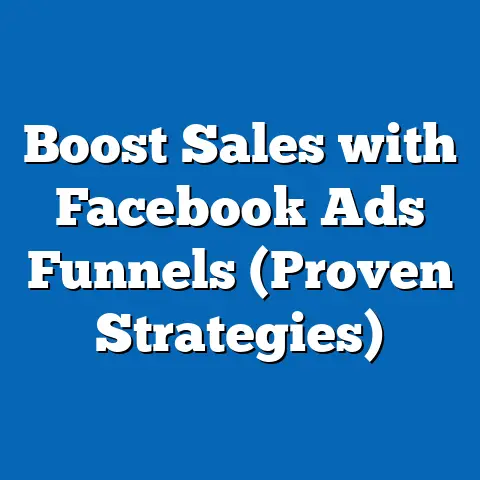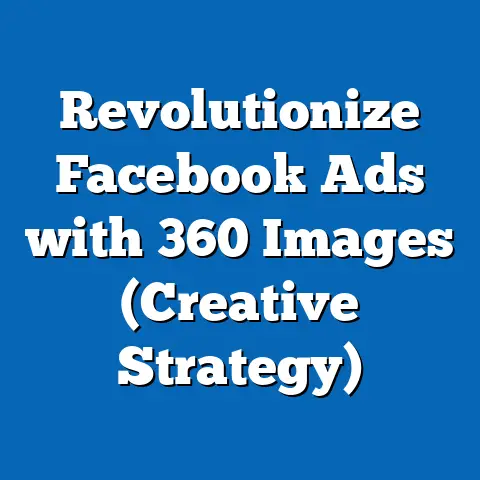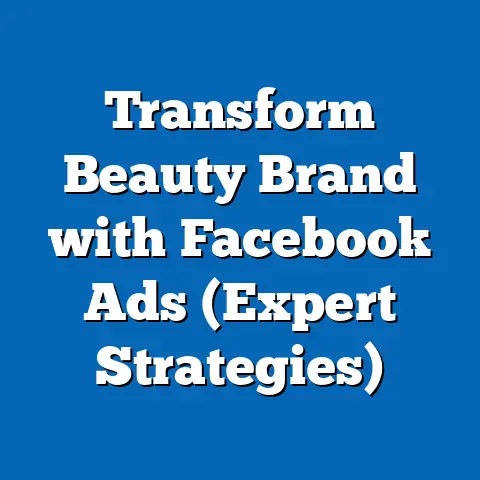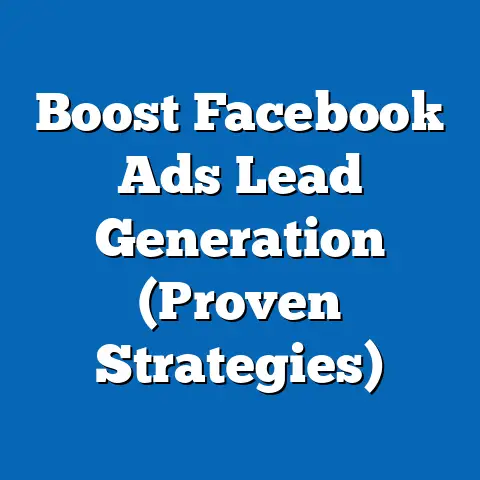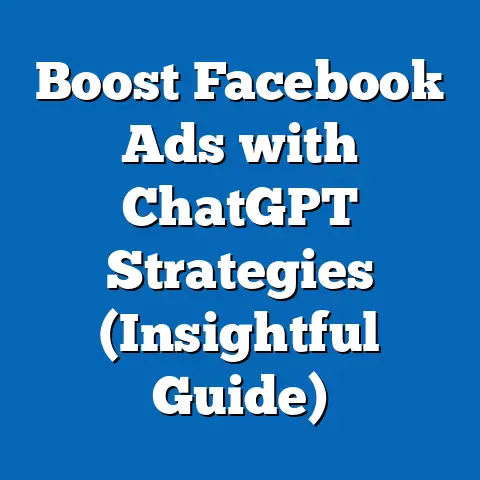Capture Real Estate Leads with Facebook Ads (Proven Strategies)
In today’s world, where environmental awareness is no longer a niche concern but a mainstream value, businesses across all sectors are feeling the pressure to adopt eco-conscious practices. The real estate industry is no exception. Consumers, especially millennials and Gen Z, are increasingly seeking homes and properties that align with their commitment to sustainability. This shift presents a tremendous opportunity for real estate agents and agencies to not only meet this demand but also to leverage it for enhanced lead generation.
I’ve seen firsthand how integrating eco-friendly messaging into marketing campaigns can drastically improve engagement and conversion rates. One of my clients, a small real estate agency specializing in sustainable homes, saw a 40% increase in leads after we revamped their Facebook ad strategy to highlight the eco-friendly features of their listings.
Understanding Your Audience
The cornerstone of any successful Facebook ad campaign lies in understanding your target audience. With the increasing emphasis on sustainability, it’s crucial for real estate agents to identify and target eco-conscious buyers and renters.
Identifying Eco-Conscious Consumers
Facebook offers a wealth of data and targeting options to help you pinpoint your ideal audience. Tools like Facebook Insights and Audience Insights are invaluable resources for uncovering the interests, behaviors, and demographics of potential leads.
- Interests: Look for individuals who express interest in topics like “sustainable living,” “eco-friendly products,” “renewable energy,” “organic gardening,” or specific environmental organizations.
- Behaviors: Target users who have engaged with content related to sustainable living, such as liking pages of environmental organizations, joining groups focused on eco-friendly practices, or attending events related to sustainability.
- Demographics: Consider demographics such as age, location, income, and education level. Millennials and Gen Z, for example, tend to be more environmentally conscious than older generations. Affluent areas often have a higher demand for eco-friendly properties.
I remember when I first started using Facebook Audience Insights, I was amazed by the level of detail available. I could see not only what people were interested in, but also what other pages they liked, what events they attended, and even what devices they used. This information allowed me to create incredibly targeted ad campaigns that resonated deeply with my audience.
Creating Eco-Conscious Buyer Personas
Beyond demographics and interests, creating detailed buyer personas can help you better understand the motivations and values of your target audience. A buyer persona is a semi-fictional representation of your ideal customer, based on research and data about your existing and potential customers.
Consider these factors when creating your eco-conscious buyer personas:
- Values: What are their core values related to sustainability? Are they concerned about climate change, pollution, or animal welfare?
- Motivations: Why are they seeking an eco-friendly property? Are they looking to reduce their carbon footprint, save money on energy bills, or live a healthier lifestyle?
- Challenges: What challenges are they facing in finding an eco-friendly property? Are they struggling to find properties that meet their criteria, or are they concerned about the cost of sustainable features?
- Preferences: What specific features are they looking for in an eco-friendly property? Are they interested in solar panels, energy-efficient appliances, water conservation systems, or sustainable building materials?
For example, you might create a persona named “Eco-Conscious Emily,” a 30-year-old millennial who works in the tech industry and is passionate about reducing her carbon footprint. She’s looking for a small, energy-efficient home in a walkable neighborhood with access to public transportation. She’s willing to pay a premium for sustainable features but is concerned about the long-term cost savings and environmental impact.
Understanding your audience through detailed buyer personas will enable you to craft highly targeted and relevant ad campaigns that speak directly to their needs and desires.
Key Takeaway: Invest time in researching and understanding your target audience. Use Facebook Insights and Audience Insights to identify eco-conscious consumers and create detailed buyer personas to guide your ad creation process.
Crafting Your Message
Once you understand who you’re targeting, the next step is to craft a compelling message that resonates with their values and motivations. Your ad copy should clearly communicate the benefits of eco-friendly properties and highlight the specific features that appeal to environmentally-minded consumers.
Showcasing Sustainable Features
Highlight the unique selling points of the properties you’re advertising. Focus on features like:
- Energy Efficiency: Energy-efficient appliances, insulation, windows, and HVAC systems.
- Renewable Energy: Solar panels, wind turbines, and geothermal systems.
- Water Conservation: Rainwater harvesting systems, low-flow fixtures, and drought-resistant landscaping.
- Sustainable Materials: Recycled building materials, bamboo flooring, and low-VOC paints.
- Green Certifications: LEED certification, Energy Star rating, and other green building certifications.
Instead of simply stating that a property has “energy-efficient appliances,” quantify the benefits. For example: “This home features Energy Star certified appliances that can save you up to 30% on your energy bills each month.”
Storytelling for Emotional Connection
Storytelling is a powerful tool for connecting with potential leads on an emotional level. Share narratives about the benefits of living sustainably, highlighting the positive impact on the environment, health, and well-being.
- Focus on the “Why”: Explain why sustainable living matters. Talk about the importance of protecting the environment for future generations, reducing pollution, and conserving natural resources.
- Share Personal Experiences: If you or your clients have personal experiences with sustainable living, share them in your ads. This can help build trust and credibility.
- Highlight the Benefits: Emphasize the positive impact of sustainable living on health, well-being, and community.
I recall working with a client who had a property with a beautiful rainwater harvesting system. Instead of just listing the feature, we created a short video showcasing how the system worked and highlighting the positive impact it had on the environment and the homeowner’s water bill. The video generated significantly more engagement than our previous ads.
Effective Headlines and Calls-to-Action
Your headlines and calls-to-action are crucial for capturing attention and driving conversions. Use strong, action-oriented language that resonates with eco-conscious consumers.
Examples of Effective Headlines:
- “Live Sustainably in Your Dream Home”
- “Reduce Your Carbon Footprint with This Eco-Friendly Property”
- “Save Money and the Planet with Energy-Efficient Living”
- “Discover Green Homes Designed for a Sustainable Future”
Examples of Effective Calls-to-Action:
- “Learn More About Sustainable Living”
- “Schedule a Tour of This Eco-Friendly Home”
- “Download Our Guide to Green Real Estate”
- “Contact Us for a Free Consultation”
Key Takeaway: Craft compelling ad copy that showcases the sustainable features of your properties, uses storytelling to connect emotionally with potential leads, and includes strong headlines and calls-to-action that drive conversions.
Designing Eye-Catching Visuals
Visuals are a critical component of any successful Facebook ad campaign. High-quality images and videos can capture attention, communicate your message effectively, and drive engagement.
High-Quality Images and Videos
Use professional-quality images and videos that showcase the eco-friendly aspects of your properties.
- Highlight Sustainable Features: Focus on the unique sustainable features of the property, such as solar panels, energy-efficient appliances, and sustainable landscaping.
- Showcase Natural Light: Use natural light to create warm and inviting visuals that highlight the beauty of the property.
- Emphasize Green Spaces: Showcase any green spaces, gardens, or outdoor areas that contribute to the property’s sustainability.
- Use Professional Photography: Invest in professional photography to ensure that your images are high-quality and visually appealing.
Branding and Aesthetics
Your visuals should align with an eco-conscious theme and reflect your brand’s values.
- Use Earthy Colors: Incorporate earthy colors like greens, browns, and blues to create a sense of naturalness and sustainability.
- Use Sustainable Branding: Use branding elements that communicate your commitment to sustainability, such as logos with natural imagery or taglines that emphasize eco-friendliness.
- Maintain Consistency: Maintain a consistent visual style across all of your ads to create a cohesive brand identity.
Infographics and Carousel Ads
Infographics and carousel ads are excellent formats for showcasing multiple properties or features in a visually appealing way.
- Infographics: Use infographics to present data and statistics about the benefits of sustainable living or the features of your properties.
- Carousel Ads: Use carousel ads to showcase multiple properties, each with its own image, headline, and description. This allows potential leads to browse multiple options and find the property that best suits their needs.
I’ve found that carousel ads are particularly effective for showcasing a range of properties with different sustainable features. By highlighting the unique aspects of each property, you can appeal to a wider audience and increase your chances of generating leads.
Key Takeaway: Invest in high-quality visuals that showcase the eco-friendly aspects of your properties, align with an eco-conscious theme, and use innovative formats like infographics and carousel ads to capture attention and drive engagement.
Utilizing Facebook Ad Formats and Features
Facebook offers a variety of ad formats and features that can be used to effectively capture real estate leads. Understanding the strengths and weaknesses of each format is crucial for optimizing your advertising efforts.
Photo Ads, Video Ads, and Slideshow Ads
- Photo Ads: Simple and effective for showcasing a single property or feature. Use high-quality images and compelling ad copy to capture attention.
- Video Ads: Ideal for showcasing the unique features of a property and telling a story about sustainable living. Use short, engaging videos that capture attention and communicate your message effectively.
- Slideshow Ads: A cost-effective alternative to video ads. Use a series of images to create a slideshow that showcases multiple properties or features.
Facebook Lead Ads
Facebook Lead Ads are specifically designed for lead generation. They allow potential leads to express interest in your properties without leaving the Facebook platform.
- Simplified Form Filling: Lead Ads pre-populate form fields with information from the user’s Facebook profile, making it easy for them to submit their information.
- Mobile-Friendly: Lead Ads are designed to be mobile-friendly, making it easy for users to fill out the form on their smartphones or tablets.
- Customizable Forms: You can customize the form fields to collect the information you need, such as name, email address, phone number, and property preferences.
I’ve found that Facebook Lead Ads are particularly effective for generating high-quality leads because they make it so easy for potential customers to express interest. The pre-populated form fields reduce friction and increase conversion rates.
A/B Testing and Retargeting
- A/B Testing: Test different ad formats, headlines, images, and calls-to-action to determine what works best for your target audience. Use A/B testing to optimize your ad campaigns and improve your lead generation efforts.
- Retargeting: Retarget users who have previously interacted with your content, such as visiting your website, watching your videos, or engaging with your ads. Use retargeting ads to re-engage these users and encourage them to take the next step, such as scheduling a tour or contacting you for a consultation.
Retargeting is a powerful tool for converting leads who have already shown interest in your properties. By showing them targeted ads based on their previous interactions, you can keep your brand top-of-mind and increase your chances of closing the deal.
Key Takeaway: Experiment with different Facebook ad formats and features to find what works best for your target audience. Utilize Facebook Lead Ads to simplify the lead generation process and use A/B testing and retargeting to optimize your ad campaigns and improve your lead generation efforts.
Measuring Success and Adjusting Strategies
The final step in any Facebook ad campaign is to measure your results and adjust your strategies accordingly. By tracking key performance indicators (KPIs) and analyzing your data, you can identify what’s working and what’s not, and make adjustments to improve your lead generation efforts.
Key Performance Indicators (KPIs)
- Reach: The number of unique people who saw your ad.
- Impressions: The number of times your ad was displayed.
- Engagement: The number of likes, comments, shares, and clicks your ad received.
- Click-Through Rate (CTR): The percentage of people who saw your ad and clicked on it.
- Cost Per Click (CPC): The average cost you paid for each click on your ad.
- Conversion Rate: The percentage of people who clicked on your ad and completed a desired action, such as filling out a lead form or scheduling a tour.
- Cost Per Lead (CPL): The average cost you paid for each lead generated by your ad.
- Lead Quality: The quality of the leads you generated, based on factors such as their level of interest and their likelihood of becoming a customer.
Analyzing and Refining
- Track Your KPIs: Use Facebook Ads Manager to track your KPIs and monitor the performance of your ad campaigns.
- Analyze Your Data: Analyze your data to identify trends and patterns. What ad formats are performing best? What headlines are generating the most clicks? What audiences are converting at the highest rate?
- Make Adjustments: Based on your analysis, make adjustments to your ad campaigns to improve your lead generation efforts. Test different ad formats, headlines, images, and calls-to-action. Refine your targeting to reach the most qualified leads.
Continuous Learning
The real estate market and consumer preferences are constantly changing. It’s important to stay up-to-date on the latest trends and best practices to ensure that your ad campaigns remain effective.
- Read Industry Publications: Subscribe to industry publications and blogs to stay informed about the latest trends in real estate and marketing.
- Attend Industry Events: Attend industry events to network with other professionals and learn about new strategies and technologies.
- Experiment and Innovate: Don’t be afraid to experiment with new ad formats, targeting options, and messaging strategies. The key to success is to continuously learn and adapt to the changing landscape.
Key Takeaway: Track your KPIs, analyze your data, and make adjustments to your ad campaigns to continuously improve your lead generation efforts. Stay up-to-date on the latest trends and best practices and be willing to experiment and innovate to stay ahead of the competition.
Conclusion
Capturing real estate leads through Facebook ads, while appealing to eco-conscious consumers, requires a strategic approach that combines understanding your audience, crafting compelling messages, designing eye-catching visuals, utilizing the right ad formats, and continuously measuring and adjusting your strategies.
By implementing the proven strategies outlined in this article, real estate professionals can effectively connect with environmentally-minded clients, build meaningful relationships, and drive business growth. Embrace these strategies, stay informed, and adapt to the changing landscape to maximize your lead generation efforts and thrive in the competitive real estate market.
Now, it’s time to take action! Start implementing these strategies in your Facebook advertising campaigns today and witness the positive impact on your lead generation efforts. Your next eco-conscious client awaits!

